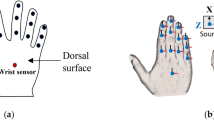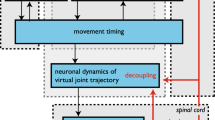Abstract
The central nervous system uses stereotypical combinations of the three wrist/forearm joint angles to point in a given (2D) direction in space. In this paper, we first confirm and analyze this Donders’ law for the wrist as well as the distributions of the joint angles. We find that the quadratic surfaces fitting the experimental wrist configurations during pointing tasks are characterized by a subject-specific Koenderink shape index and by a bias due to the prono-supination angle distribution. We then introduce a simple postural model using only four parameters to explain these characteristics in a pointing task. The model specifies the redundancy of the pointing task by determining the one-dimensional task-equivalent manifold (TEM), parameterized via wrist torsion. For every pointing direction, the torsion is obtained by the concurrent minimization of an extrinsic cost, which guarantees minimal angle rotations (similar to Listing’s law for eye movements) and of an intrinsic cost, which penalizes wrist configurations away from comfortable postures. This allows simulating the sequence of wrist orientations to point at eight peripheral targets, from a central one, passing through intermediate points. The simulation first shows that in contrast to eye movements, which can be predicted by only considering the extrinsic cost (i.e., Listing’s law), both costs are necessary to account for the wrist/forearm experimental data. Second, fitting the synthetic Donders’ law from the simulated task with a quadratic surface yields similar fitting errors compared to experimental data.










Similar content being viewed by others
Notes
Anatomically speaking, only flexion--extension and radial--ulnar deviation are part of the wrist, while pronation--supination is part of the forearm, but functionally they all contribute to the final 3D orientation of the hand.
In general, wrist joint of mechanical systems involve singularities; however, the restriction to physiological range of motion of the human wrist joints (Table 1) allows using singularity-free transformations.
Definition (4) is ambiguous whenever \(\user2{n}=\pm \user2{e}_x\). However \(\user2{n}=-\user2{e}_x\) is out of the physiological range, as it corresponds to a π radians rotation. The case \(\user2{n}=\user2{e}_x\) corresponds to θ = 0 and since \(|\user2{r}_L|=\theta\), we assume by continuity that \(\user2{r}_L=0\) whenever θ = 0.
The isosurfaces of extrinsic costs Eq. (8) are concentric spheres in the end-point space. The isosurfaces of discomfort functions are ellipsoids in the joint space \((F_{\rm intr}(\varvec{\theta})=\hbox{const})\). When mapped back to the end-point space via the inverse kinematics map, the smooth and concentric shell-like structure is maintained since \(\hbox{IK}(\user2{r})\) is a smooth mapping and Eq. (12) is linear.
References
Andrews JG, Youm Y (1979) A biomechanical investigation of wrist kinematics. J Biomech 12:83–93
Blohm G, Crawford JD (2007) Computations for geometrically accurate visually guided reaching in 3-D space. J Vision 7(5):4, 1–22
Campolo D, Formica D, Guglielmelli E, Keller F (2010) Kinematic analysis of the human wrist during pointing tasks. Exp Brain Res 201:561–573
Ceylan M, Henriques DYP, Tweed DB, Crawford JD (2000) Task dependent constraints in motor control: pinhole goggles make the head move like an eye. J Neurosci 20:2719–2730
Cruse H, Wischmeyer E, Bruwer M, Brockfeld P, Dress A (1990) On the cost functions for the control of the human arm movement. Biol Cybern 62:519–528
Cruse H (1986) Constraints for joint angle control of the human arm. Biol Cybern 54:125–132
Do Carmo MP (1976) Differential geometry of curves and surfaces. Prentice Hall, New Jersey
Donders FC (1847) Beitrag zur Lehre von den Bewegungen des menschlichen Auges. Holland Beitr Anat Physiol Wiss 1:104–145
Engelbrecht SE (2001) Minimum principles in motor control. J Math Psychol 45:497–542
Franklin DW, Burdet E, Tee KP, Osu R, Chew CM, Milner TE, Kawato M (2008) CNS learns stable, accurate, and efficient movements using a simple algorithm. J Neurosci 28(44):11165–11173
Guigon E, Baraduc P, Desmurget M (2008) Optimality, stochasticity, and variability in motor behavior. J Comput Neurosci 24:57–68
Hansard M, Horaud R (2010) Cyclorotation Models for Eyes and Cameras. IEEE Trans Syst Man Cybern B Cybern 40:151–161
Hepp K (1995) Theoretical explanations of listing’s law and their implication for binocular vision. Vis Res 35:3237–3241
Hepp K (1990) On Listing’s law. Commun Math Phys 132:285–292
Hoffman DS, Strick PL (1993) Step-tracking movements of the wrist. III. Influence of changes in load on patterns of muscle activity. J Neurosci 13(12):5212–5227
Hore J, Watts S, Vilis T (1992) Constraints on arm position when pointing in three dimensions: donders law and the fick-gimbal strategy. J Neurophysiol 68:374–383
Koenderink JJ, van Droon AJ (1992) Surface shape and curvature scales. Image Vis Comput 10:557–564
Leonard L, Sirkett D, Mullineux G, Giddins GEB, Miles AW (2005) Development of an in-vivo method of wrist joint motion analysis. Clin Biomech 20:166–171
Montgomery R (2002) A tour of subriemannian geometries, their geodesics and applications. Mathematical surveys and monographs, 91. American Mathematical Society, Providence, RI, USA
Murray RM, Li Z, Sastry SS (1994) A Mathematical introduction to robotic manipulation. CRC Press, Boca Raton
Pennestrì E, Stefanelli R, Valentini PP, Vita L (2007) Virtual musculo-skeletal model for the biomechanical analysis of the upper limb. J Biomech 40:1350–1361
Shoemake K (1985) Animating rotation with quaternion curves. In: Proceedings of the 12th annual conference on computer graphics and interactive techniques (SIGGRAPH), 16(3):245–254, San Francisco, CA, USA, Jul 22–26
Todorov E (2004) Optimality principles in sensorimotor control. Nat Neurosci 7:907–915
Tweed D, Vilis T (1990) Geometric relations of eye position and velocity vectors during saccades. Vis Res 30:111–127
Wong AMF (2004) Listing’s law: clinical significance and implications for neural control. Surv Ophthalmol 49:563–575
Wu G et al (2005) ISB recommendation on definitions of joint coordinate systems of various joints for the reporting of human joint motion—part II: shoulder, elbow, wrist and hand. J Biomech 38:981–992
Acknowledgments
This study was partially funded by the Academic Research Fund (AcRF) Tier1 (RG 40/09), Ministry of Education, Singapore, and by the EU FP7 VIACTORS project. The authors are grateful to Ms Kelly Savin for proofreading the manuscript.
Author information
Authors and Affiliations
Corresponding author
Appendix: Notations for wrist orientation
Appendix: Notations for wrist orientation
Endpoint space representations
The 3D orientation of a rigid body such as the human wrist can be described by means of a 3 × 3 rotation matrix R (satisfying ortho-normality R T R = I and ‘right-handedness’ det R = +1). A rotation is physically determined once the rotation axis \(\user2{n}\) (\(|\user2{n}|=1\)) and the rotation angle θ are known, thus can be described by a rotation vector \(\user2{r} = \theta \user2{n}\). The rotation matrix R corresponding to a rotation vector \(\user2{r}\) can be computed via the Rodrigues’ formula (Murray et al. 1994):
where the skew-symmetric matrix \(\widehat{\user2{r}}\) is defined through:
Conversely, for a given rotation matrix R, the corresponding rotation vector can be computed as:
where θ = arccos((trace(R) − 1)/2), valid for θ < π.
Forward kinematics
Following the axes conventions of Wu (2005), the wrist orientation R can be computed as the ordered product of three rotations:
and the corresponding rotation vector is:
Inverse kinematics
If the wrist orientation is given by the rotation matrix R, the joint angles \(\varvec{\theta}=[\theta^{\rm RUD}\,\theta^{\rm FE}\,\theta^{\rm PS}]^T\) can be computed as the Euler angles (Shoemake 1985). Although, in general, there are several solutions, the biomechanical range of motion of the wrist (see Table 1) yields a unique joint angles configuration for any reachable orientation:
Rights and permissions
About this article
Cite this article
Campolo, D., Widjaja, F., Esmaeili, M. et al. Pointing with the wrist: a postural model for Donders’ law. Exp Brain Res 212, 417–427 (2011). https://doi.org/10.1007/s00221-011-2747-3
Received:
Accepted:
Published:
Issue Date:
DOI: https://doi.org/10.1007/s00221-011-2747-3




